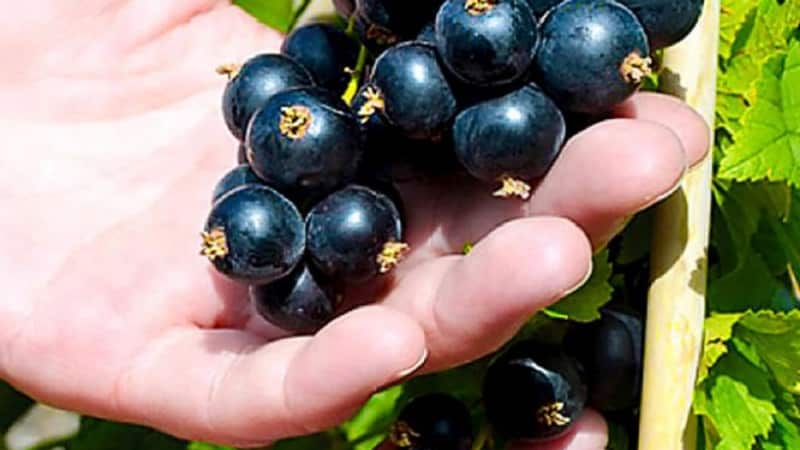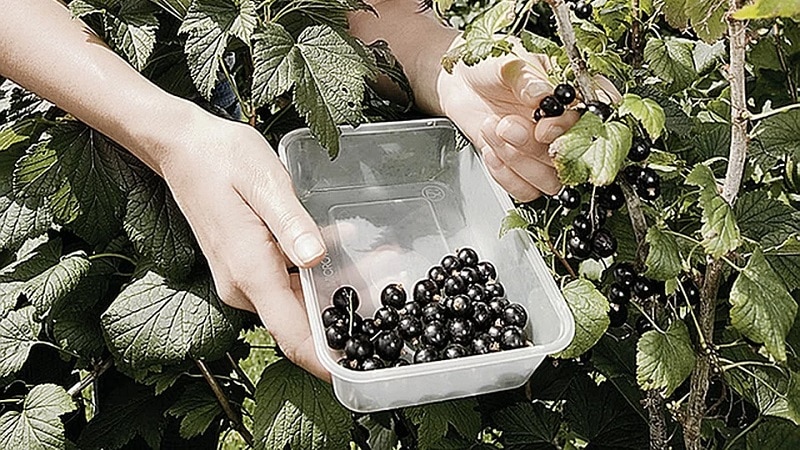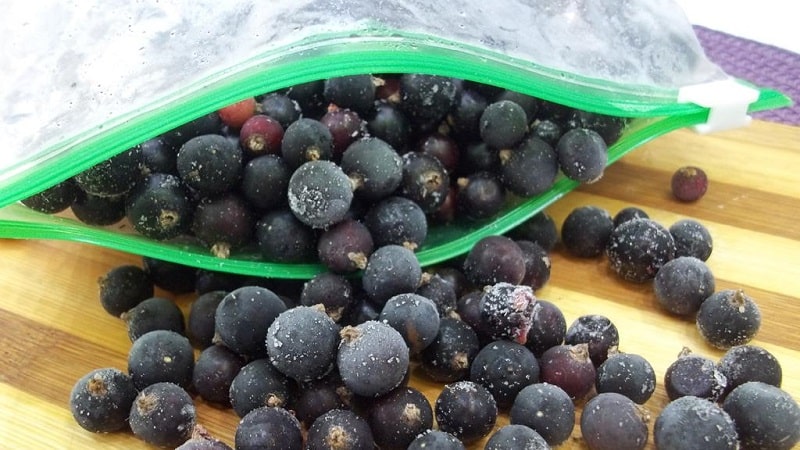How and when to pick blackcurrants correctly
At Russian dachas black currant - the most popular berry. The shrub is unpretentious and grows almost everywhere. A great variety of varieties have been bred: sour and sweet with a slight sourness, small and more than a centimeter in diameter, early June and late, ripening by mid-August. Delicious, vitamin-rich berries can be eaten straight from the bush, processed or stored until next season, dried or frozen. How and when to pick blackcurrants to get the maximum benefit – we’ll talk about this in the article.
How to determine the degree of ripeness of berries
You can start harvesting after making sure that the berries are ripe. Unripe fruits are usually hard, sour, green or brown in color..
When the berries have acquired a rich black, sometimes with a purple tint, hue, the brushes on which they grow changed color from emerald to brown, the fruits began to be easily separated from the stalks, the currants fall off from a light touch on the branch - this is a signal for harvesting.
It is important to know! The matte or glossy surface of the skin depends on the variety. It is incorrect to judge the health or ripeness of berries using it.
Beginning gardeners often ask whether it is possible to harvest unripe currants. Professionals believe it is possible. Is it true, unripe fruits have few beneficial properties and are not suitable for harvesting for the winter. This berry is not recommended for people with a weak gastrointestinal tract.
Harvesting unripe crops makes sense in one case: if long-term transportation is planned. In a cool place, black currants ripen in 5-7 days.

When to Harvest
All types of garden blackcurrants divided into early, mid-season and late.
Bush early currant varieties blooms in early May and by mid-June pleases gardeners with ripe berries. However, in the northern regions of the country and in Siberia, where the summer season is just beginning in the first ten days of May and spring frosts are common, such varieties are useless. Therefore, it is recommended to grow early currants only in the southern regions.
Currants of mid-season and mid-late varieties are the most popular in our country. It takes root well in all climatic zones suitable for agriculture. The flowering of the medium-ripening shrub begins in the second half of May. During this period, flowering bushes rarely freeze. Already in the second ten days of July, gardeners begin to harvest the long-awaited harvest.
In mid-late varieties of currants The period of flowering and fruiting begins a week later than in mid-season ones.
Late varieties are recommended for cultivation in the northern regions, where there are frosts in early June. Late currants bloom in late May - early June. The berries ripen only in the first ten days of August, and sometimes closer to the middle of the month. These varieties are believed to be very rich in vitamins due to their long ripening time.
How to properly collect currants from bushes
Black currants, unlike red and white ones, ripen unevenly. That's why no need to try to pick the whole bush at once. Harvesting begins when most of the fruits are ripe.
Remember! Black currants very quickly, especially in rainy weather, become overripe, crack and crumble. Therefore, the crop should be harvested immediately, without stretching this process for weeks.
If the berries are so ripe that easily separated from the stalk, do not try to pick only with brushes. Contrary to popular belief, currants picked by berry will not be crushed and will not leak juice. Immediately after collection, it is advisable to put it in the refrigerator or a cool, shaded place in the country.
Picking with brushes has 2 advantages: significantly speeds up harvesting and protects fruits from damage during transportation. But there is also a significant disadvantage: before processing, the berries will have to be cleared of debris, which means additional time and effort.
Lazy summer residents have come up with a way to quickly pick currants from the bushes: cover the ground under the plant with cloth or cellophane, pick the fruits with both hands. After the harvest is harvested, pour it from the litter into a bucket. With this method of picking, you need to sort the berries before you start harvesting.

Preparation for long-term storage
After picking, blackcurrants need to be quickly eaten or processed. Ripe berries retain their presentation for no more than 5 days in the refrigerator or about a day in a warm place. During long-term storage, the fruits become moldy, begin to ferment and become unsuitable for further use.
Before starting to prepare currants separated from leaves, crushed fruits and other rubbish. This is usually done by hand, but if there are a lot of berries, simple methods are used.
The currants are carefully poured from the bucket into a wide dish (basin, deep bowl), poured with cold water and stirred slightly. Small debris floats to the surface. The liquid is drained.Then the berries are collected from the brushes by hand and separated from the stalks.
You can remove the fruit quickly and easily using a fork.. To do this, the bunch is pulled between the teeth, and the currants fall off. This method is suitable if the berry is not too ripe. You should act carefully so as not to crush the fruits and turn the entire harvest into jelly.
Note! The stalks remaining on the berries do not change the taste of the preparation and do not affect the duration of storage.
There is another way to separate fruits from litter. A cutting or ribbed washing board is installed in the tray at an angle of 60-70°. The collected currants are poured in parts onto an inclined surface. The berries are rolled into a tray, and the trash remains on the board. It is swept away before each new portion of berries.
Be sure to add currants before cooking wash gently with cold water.
Proper storage
Currants bear fruit only in summer. Therefore, in order save vitamins and the exquisite taste of the berry, it is important to provide it with suitable conditions.
Housewives have mastered several ways to prepare currants for long-term storage.
To freeze
Freezing rules and storage of frozen fruits:
- dry fruits are scattered into plastic bags and placed in the freezer;
- the colder it is in the freezer, the longer the currants are stored;
- in modern chambers that maintain a temperature of -18°C and below, the berries can remain until the next harvest;
- Before use, the bag with the frozen contents is transferred to the top shelf of the refrigerator so that the berry thaws gradually and does not lose its density and shape.

Dry
Drying garden berries not difficult:
- in hot weather, currants are dried in the sun, in a draft;
- in rainy summers they use the oven: scatter the berries on a baking sheet in a thin layer and leave for 2-3 hours at a temperature of 200-230°C, with the door slightly open;
- it is important that the berries dry out, otherwise they will simply rot;
- the dried fruits are transferred to a glass container, cardboard box or linen bag;
- Store in a dry place at room temperature for one year.
Cook something delicious
Let's remember several popular recipes for winter preparations from black currants.
Fresh currants with sugar
Ingredients:
- currants – 1 kg;
- sugar – 2 kg (if the workpiece will be stored in a cool place, for example, in a cellar, 1.5 kg of sugar is enough).
Preparation:
- Wash the currants and dry.
- Grind with a blender or pass through a meat grinder.
- Mix berries with sugar. Heat slightly to dissolve the sugar faster.
- Place in sterilized glass jars, sprinkle with a spoonful of sugar on top and close with lids.
Jelly-like jam
Ingredients:
- currants – 1 kg;
- sugar – 1 kg;
- water – 1 tbsp.
Preparation:
- Mix water with sugar.
- Place over low heat and, stirring constantly, completely dissolve the sugar.
- Pour washed currants into boiling syrup.
- Cook for 10 minutes, collecting foam.
- Pour the jam into clean, sterilized jars and screw on the lids.
- Turn the jars over and cover with a blanket until completely cool.

Currant liqueur
Ingredients:
- currants – 0.5 kg;
- vodka – 0.5 l;
- sugar – 250 g;
- water – 1 tbsp.
Preparation:
- Mash the berries and transfer to a glass jar.
- Pour vodka and leave for a week.
- Shake the container periodically to prevent the berries from sticking together into a lump.
- After 7 days, strain the tincture.
- Squeeze the berries thoroughly, then the taste of the drink will become more intense.
- Boil syrup from sugar and water and mix it with the tincture.
- Store the drink in a cool place.
Advice from experienced gardeners
A few tips for summer residents from those who have been growing currants for many years:
- The best time for harvesting is in the morning, when it is not yet hot and the dew has already dried, or in the evening. Fruits picked in hot weather quickly deteriorate.
- For fresh consumption, currants are collected in any weather. For long-term storage, it is better to do this on a dry, clear day.
- The harvest must be collected in clean and dry containers.
- It is not recommended to pour berries from one container to another unless absolutely necessary.
Conclusion
Collecting and processing blackcurrants is a long and tedious process. To save the harvest, you need to follow simple rules. Start picking berries without waiting for the entire bush to ripen. In the heat of the day or rainy weather, it is better to rest and move the harvest to a dry, warm morning or evening. The container for the berries must be dry and clean. And pouring from bucket to bucket will not bring any benefit, it will only damage the fruit.
Properly harvested currants will be stored for a long time, delight in taste and provide vitamins all year round for both adults and children.